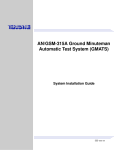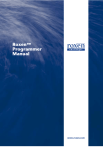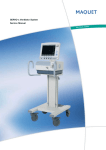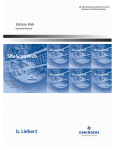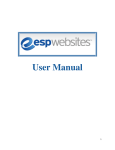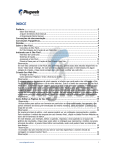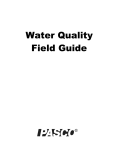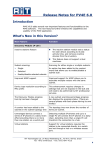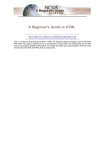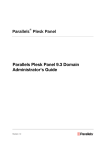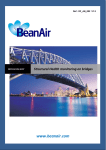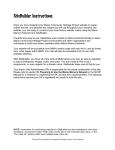Download Roxen CMS 5.4 - LogView Module Manual
Transcript
Roxen CMS 5.4 LogView Module Manual 2014-03-11 www.roxen.com Roxen Internet Software AB © 2011 Roxen Internet Software AB. All rights reserved. Your rights to the software are governed by the accompanying software license agreement. Under the copyright laws, this document may not be copied, in whole or in part, without the written consent of Roxen Internet Software. Every effort has been made to ensure that the information in this document is accurate. Roxen Internet Software is not responsible for printing or clerical errors. Roxen Internet Software Box 449 SE-581 05 Linköping Sweden www.roxen.com Other company and product names mentioned herein are trademarks of their respective companies. Roxen Internet Software assumes no responsibility with regard to the performance or use of these products. 2 Contents 1 LogView Module 5 2 Using LogView 6 3 Logging Sites 7 4 Statistics 8 4.1 Selecting Statistics Group 8 4.2 Selecting Period of Time 8 4.3 Selecting Kind of Statistics 8 4.4 Selecting Format 9 5 Reports 11 6 Advanced 12 6.1 Selecting Group 12 6.2 Selecting Report 12 6.3 Selecting Presentation 13 6.4 Selecting From and To Values 14 6.5 Selecting Display 15 6.6 Tables 15 6.6.1 6.6.2 HTML table ASCII table 15 15 6.7 Charts 16 6.7.1 6.7.2 6.7.3 6.7.4 6.7.5 Line chart Bar chart Sum bars chart 2D pie chart 3D pie chart 16 16 17 17 17 6.8 Miscellaneous 18 6.8.1 6.8.2 6.8.3 Map Export Tag 18 18 18 7 Terms and Functions 19 7.1 Terms 19 7.2 Functions 19 7.3 Site Activity 19 2014-03-11 LogView Module 3 7.4 Visitor Origins 20 7.5 Authentications 20 7.6 Popular Contents 20 7.7 Visitor Sessions 20 7.8 Visitor Profiles 21 7.9 Pathways 21 7.10 Search 21 7.11 Download 22 7.12 Maintenance 22 7.13 Extensions 22 8 Administrating LogView 23 8.1 Internal and External Logs 23 8.2 Statistics Groups 23 8.3 Databases 23 8.4 Updates 23 9 Installing 24 10 Configuration 25 10.1 Update 25 10.2 Logs 25 10.2.1 10.2.2 10.2.3 Log to configure Status and Log name Miscellaneous attributes 25 26 26 10.3 Statistics Groups 26 10.4 Example 27 10.5 Import Logs 27 10.6 Delete Logs 28 10.7 Rebuild/Delete Statistics Group 28 10.8 Report Maker 28 10.9 Delete Report 28 11 Troubleshooting 29 11.1 The Installation of LogView Failed 29 2014-03-11 LogView Module 4 1 LogView Module LogView is an integrated log analysis tools can report which pages that are most frequently accessed, by whom, where from and how. Roxen CMS can generate graphs for easy overviewing of a number of different statistics measurements and all data is updated hourly. It imports Common Log Format (CLF) files and also supports log aggregation from several servers into the same report. The design allows for more than 1 GB of log data added each day. Specifications: • Statistics available on activity, origins, popular content, profiles, links, search engines and more • Handles more than 1 GB of new log data each day • Analyze HTTP, FTP and proxy logs • Import and integrate older logs • Aggregate logs from several servers • Group different server logs • Store logs in internal database • Analyze data on any scale – yearly to hourly • Compliant with CLF 2014-03-11 LogView Module 5 2 Using LogView LogView lets the user view the gathered statistics in an ordinary web browser. If LogView has been installed on the Roxen virtual server with the URL http://hostname/intranet/ The default URL to the LogView configurations page is http://hostname/intranet/logview/ However, the administrator may choose another location within the virtual file system. If the administrator has specified that access to the LogView pages should be password protected, the user will get a pop-up dialog where he has to log in before he can access the LogView page. On the top of all the LogView pages there is a button menu which helps the user to navigate between the three pages Report, Statistics and Advanced. These pages provide different ways of looking at the gathered statistics. The main difference between the Statistics, Reports and Advanced pages lies in what possibilities the user has to affect the presentation. The Reports page contains a number of reports that has been prepared by the administrator, and is therefore the most static one - all the user needs to do is to select which report he wishes to see. The Statistics page is an easy way to create reports, and provides basic possibilities to control what statistics to see and in which form, and in the Advanced page the user has even more freedom to control the details. These three levels of control possibilities makes it possible to provide quick-and-easy access for the users who either do not need full control or can have the administrator or site creator tailor a report for them, while the users that really need full control over the details can still get it. 2014-03-11 Using LogView 6 3 Logging Sites When someone retrieves a page from a web site, all the actions this person does are saved to a file in a special log format. Every action from downloading files, fetching HTML-pages with pictures, to what web-browser or operating system the user has is saved as plain text in this file. This file can later be analyzed to find out various behaviors the site's users have. The process of building a log file works something like this: the user's browser sends requests to your Web server for various resources. These resources may include HTML, graphics, audio, and whatever other types of files there are on the site. Upon receiving the request from a browser, your Web server accesses the file and sends it back to the client browser. A lot of useful information is buried in this file. With this information, it is possible to find out for example where bottlenecks and errors occur in the server or on the site, or which are the most popular features on the site. The information gathered in the log files can as all statistics information be made to fool those not as attentive or those who do not have any knowledge about the area the statistics is covering. Here is a screen-shot that there is obviously something fishy about. Figure 1. It is easy to fool those who are not paying attention. To make the best use of statistics information it is important to know what all functions and special terms concerning LogView means. Hence, a compilation of all the important terms and functions in LogView can be found in the Terms and Functions page. 2014-03-11 Logging Sites 7 4 Statistics The statistics page provides an easily overviewed and almost self-explanatory way of looking at statistics gathered by all the functions that are enabled on the current statistics group. 4.1 Selecting Statistics Group In the field labeled Group the current statistics group is shown. If several groups are defined, the user can select one of them in a list box. By default only one group is defined. It takes its data from the log of the Roxen virtual server that LogView is installed on, and the name of this group is the same as the name of the server. If no hits have been received since the creating of the selected statistics group, this is shown by the message "No items are logged". This should be remedied within one hour after the site has been accessed. Figure 2. Select group and period of time. 4.2 Selecting Period of Time In the Period of time box, the period of time for which to show statistics can be specified. The currently selected period of time is displayed within parentheses right next to the label on the top of the box. The highlighted periods inside the box are the ones for which logged data is available, and clicking one of them simply selects that period of time. By default only years and months are shown, but once a month is selected the box is expanded to also contain weeks and days. On the Statistics page, statistics can only be shown for a single year, month, week or day. To specify a more exact time interval, the user has to go to the Advanced page. 4.3 Selecting Kind of Statistics Below the Period of time box, a number of available functions are listed in groups. To see statistics of a certain kind the user just has to select the corresponding function in the list. An overview over the functions can be found in the Terms and Functions page. 2014-03-11 Statistics 8 Figure 3. Select statistics function. 4.4 Selecting Format Once the user has selected the kind of statistics to show, a report is displayed at the bottom of the page. This report is in a default format that is dependent of the kind of statistics that was selected. If the user is not pleased with this format, she can choose another one in the list box in the title of the report. Below is a selection of statistics reports for www.roxen.com during week 6, 2001. These reports selected by first choosing the www.roxen.com group, then clicking on 2001, Feb and last week 6. Figure 4. Download hits - line chart. This report is selected by clicking on the function Download hits and then choosing line chart from the pull down menu. 2014-03-11 Statistics 9 Figure 5. Download hits - bar chart. This report is selected by clicking on the function Download hits and then choosing bar chart from the pull down menu. Figure 6. External links, pages - table. This report is selected by clicking on the function External links, pages and then choosing table from the pull down menu. Figure 7. Return code summary - 3D pie chart. This report is selected by clicking on the function Return code summary and then choosing 3d pie chart from the pull down menu. 2014-03-11 Statistics 10 5 Reports The report page is used for viewing reports that have been prepared by the LogView administrator. 2014-03-11 Reports 11 6 Advanced In this page, the user can control all of LogView's capabilities for viewing statistics. Figure 8. The advanced statistics page. 6.1 Selecting Group Figure 9. Select statistics group. As was the case on the Statistics page, the statistics group, if more than one is available, can be selected in a list box. 6.2 Selecting Report Figure 10. Select type of report. The user can select the kind of report from all the kinds that are available for the selected statistics group in the first list box on the row. The list box after as default labeled Day is used to specify the granularity of the diagram or table. If days is selected here, a resulting bar chart will have one bar for each day for which data is available, and a table will accordingly have one row for each day. If instead month is selected, the bar chart will have one bar for each month, with a height that is the the sum of the all the values of the days of this month. 2014-03-11 Advanced 12 The list box labeled per selects what should be printed for example as labels on the bars of a bar chart. To get a chart where each day has it's own bar and the label YearWeek-Day (e.g. 2001-25-Tue) the user can select the report to be shown "as day, per week". A report that is "as day, per month", has the label Year-Month-Day (e.g. 2001Jun-19) on its bars instead. Trying to set the as value larger than the per value gives the following error message: LogView Error: unit cannot be greater than per Setting both values equal has an interesting effect when using the Sum feature, as we will see in the next section. 6.3 Selecting Presentation Figure 11. Select presentation. In the first list box, the user can choose between Append or Sum. Append is the default, and gives sums for each day, week, month or year. Using the Sum feature changes this behavior somewhat - instead of summing the data inside each day, month or year the data for several such units can be summed, to answer questions like “how many hits were processed in total between 2000-10-02 and 2000-11-11?” However, to use this feature we have to use the trick to set the as and per time periods the same. The two pictures below show the difference in Append and Sum when the setting is week per week. The report is Search engines and the time period is between 200102-05 and 2001-02-18. Figure 12. Append. 2014-03-11 Advanced 13 Figure 13. Sum. Another scenario is when the user has set the report to days per week, and the time period is three weeks, where Append will present it as three weeks in a row. Sum will instead present it as one week, where each weekday is the sum of that weekday in all three weeks. Due to lack of space no screen-shots of this scenario is possible in the manual. There is also a possibility to set the maximum number of rows to be shown. The term rows seem to imply the use of a table, but the limitation works on all kinds of diagrams as well, and then limits the number of bars, pie slices or other corresponding items. 6.4 Selecting From and To Values Figure 14. Select time period. The user can specify the exact time period for which statistics should be shown by selecting the years, months and days for the beginning and end of the period. 2014-03-11 Advanced 14 6.5 Selecting Display Figure 15. Select display type. When the user has specified all of the above, she can start the display process by pressing one of the display buttons in the row at the bottom of the page. These are divided into categories by their form of presentation. 6.6 Tables 6.6.1 HTML table Figure 16. Hits at www.roxen.com, w 05 2001 through w 09 2001. (Settings: Hits as Weeks per Month, Append) 6.6.2 ASCII table Figure 17. Most active domains at www.roxen.com, w 05 2001 through w 06 2001. 2014-03-11 Advanced 15 (Settings: Most active domains as Week per Month, Sum) 6.7 Charts 6.7.1 Line chart Figure 18. Unique hosts at www.roxen.com, January 2001 through February 2001. (Setting: Unique hosts as Week per Month, Append) 6.7.2 Bar chart Figure 19. Search engines at www.roxen.com, w 06 2001. (Settings: Search engines as Week per Month, Append) 2014-03-11 Advanced 16 6.7.3 Sum bars chart Figure 20. Most active countries at www.roxen.com, January 2001 through February 2001. (Settings: Most active countries as Week per Week, Sum, max 7 rows) 6.7.4 2D pie chart Figure 21. Search engines at www.roxen.com, January 2001 through February 2001. (Settings: Search engines as Week per Week, Sum) 6.7.5 3D pie chart Figure 22. Hits at www.roxen.com, January 2001 through February 2001. 2014-03-11 Advanced 17 (Settings: Hits as Week per Week, Append) 6.8 Miscellaneous 6.8.1 Map A world map, nice for displaying statistics over Most active countries. Not available in any other case. Below is a slightly cut version of the map, made for this manual. Figure 23. Most active countries at www.roxen.com, January 2001 through February 2001. (Settings: Most active countries as Week per Month, Append) 6.8.2 Export Exports the table in a tab/newline separated format, suitable for MS Excel. 6.8.3 Tag Displays the LogView RXML tag with all the parameters that generates the created report. Great for cut-and-paste! Figure 24. Most active countries at www.roxen.com, September 1998 through July 1999. (Settings: UTSL! (Use the source, Luke!) or read the tag-code and find out the right settings.) 2014-03-11 Advanced 18 7 Terms and Functions 7.1 Terms This part describes the difficult words and terms in LogView. These words are either web analysis terms or used by LogView to describe its functions. Bandwidth In a general sense, this term describes information-carrying capacity. In LogView this applies to how much data (in bits per second) that has been transferred from the server. Hit A hit is a request from a browser to the server. Every element of a requested page, text, pictures, and interactive items is counted as one hit to the server. A normal web page contains an average of at least six elements, i.e. six hits. Hits is not the preferred way of measuring traffic on a site as the number of hits often varies widely. Page load Page load, page views or page deliveries gives the number of times a web page has been requested. Page load, not hits, are the preferred counting method sitetraffic estimates and measurement. Search engine The search functions can identify the following search engines: AOL Netfind, Alta Vista, Excite, Infoseek, Hotbot, Lycos and Yahoo. Session A session is tied to a host name where the hits have occurred up to 20 minutes between each other. Period of time/time period In LogView reports can be created to show the data between two points of time. What is in between those two points of time is the period of time. User variable Variables which the administrator or the privileged user can set in one of the LogView wizards found in the configurations interface. Some of the functions makes use of these variables when monitoring the log files. This term is only used when describing some of the functions below. 7.2 Functions This part describes all the functions used to present data about the site in LogView. 7.3 Site Activity This group of functions monitors the overall activity on the site. Hits Gives a summary of the number of hits during the period of time. 2014-03-11 Terms and Functions 19 Page load Sums the number of hits per time period and page. Bandwidth Calculates the average number of sent bits per second and time period. 7.4 Visitor Origins This group of functions monitors where hits originate from. Most active countries This function describes which countries are generating the most hits. Most active domains This function tells which internet domains are responsible for generating most hits. A domain can be roxen.com, foobar.net, etc. Most active hosts This term gives a summary of each host's hits. The most active host is the one who has the most hits. A host can be e.g. an IP-number. 7.5 Authentications Gives information about user logins. Authenticated users Gives a summary of the number of hits/time period and authenticated user. Authenticated hosts & users Gives a summary of the number of hits/time period, host name and the authenticated user. 7.6 Popular Contents This group of function monitors what has been requested on the site. Popular pages Gives a summary of hits/time period and page. Popular non-pages Gives a summary of hits/time period and non-page, where non-pages are all files which are not pages, e.g. a zip-file or a pdf-document. Popular directories Gives a summary of hits/time period and directory. 7.7 Visitor Sessions This group of functions gives information about visitors’ coherent sessions. Average hits & pages per session This function calculates the average number of hits and the average number of pages per time period and session. 2014-03-11 Terms and Functions 20 Average session length This function calculates the average session length in minutes per time unit. Most frequent entry pages Sums the number of hits per time period and page where the page is the first page accessed in a session. Most frequent exit pages Sums the number of hits per time period and page where the page is the last page accessed in a session. 7.8 Visitor Profiles This group of functions gives miscellaneous information about the users. Most common OS Sums the number of hits per operating system and time period. Most common browser Sums the number of hits per browser and time period. Most common browser & version Sums the number of hits per unique browser version and time period. Most common browser, version & OS Sums the number of hits per unique browser version, its operating system and time period. 7.9 Pathways This group of functions monitors links that point towards the site. Internal links, pages Sums the number of hits to the linked page (the To page) where the link-page (the From page) was an internal page. Pages that match the user variables Server Domain Name or Server Alias are counted as internal pages, e.g. all pages on your.site.com are internal pages. External links, pages Sums the number of hits to the linked page where the link page was an external page. External links, non-pages Calculates the number of hits to files which are not pages, e.g. zip-files and pdf documents. 7.10 Search This group of functions gives information about visitors who have found the site using search engines. Search hits Sums the number of hits where the previous page was a search engine. 2014-03-11 Terms and Functions 21 Search words Sums the number of words in the search string per time period where the previous page was a search engine. The stop words 'and', 'or', 'not', 'the', 'an', 'a', 'is' and 'are' are not counted. Search phrases Sums the number of phrases per time period where the previous page was a search engine and the phrase a search string. Search engines Sums the number of hits per search engine where the previous page was a search engine. 7.11 Download This group of functions monitors which downloads have been made. Download hits Sums the number of hits per time period where the filename matches the user variable Download files i.e., total number of downloads. Popular files Sums the number of hits per time period and filename, where the filename matches the user variable Download files i.e., sorted by files. 7.12 Maintenance This group of functions gives information necessary for troubleshooting. Return code summary Sums the number of returned status codes. Error code specification Sums the number of returned status codes per time period and filename, where the status code is an error code, i.e. separated from 200 and the interval 300399. 7.13 Extensions This function monitors the number of unique hosts who have accessed the site. Unique hosts Sums the number of hits per time period and unique host, where a host can be represented by a hostname or an IP-number. It should be noted that both hostname and IP-number can represent the same host, which implies that they will be counted as two different hosts. This is a known bug. 2014-03-11 Terms and Functions 22 8 Administrating LogView This is the administrator's part of the LogView manual. This part contains information of how to install and configure LogView, but to increase the understanding of these subjects, we start out with a deeper survey over the LogView system. 8.1 Internal and External Logs LogView handles two types of logs; logs that LogView collects itself, one for each virtual server it is installed to, and log files in Common log format that are created in other ways and imported to LogView. The first kind contains the most information and can therefore be used to create more complex statistics. All logs that LogView creates are compressed to save disk space. 8.2 Statistics Groups A statistics group consists of one or more logs as well as a configuration of statistics functions. Statistics groups makes it possible to view statistics from several log files, for example if the web site is handled by several web servers. It is also possible to configure exactly what statistics should be calculated, by choosing which statistics functions to enable. 8.3 Databases LogView keeps a database for each function enabled on each statistics group. In these databases, LogView stores information that has been extracted from the logs by the functions. For example, if the function Most common browser is enabled on a group, a database is created to store the number of hits per used browser type. Inside the databases, the data is divided into different tables per a time unit, most often per day or hour. In this way, when the user requests a specific kind of statistics for a specific group and time interval, LogView can easily get the information needed to calculate the statistics from the database. 8.4 Updates Once a day, once an hour, or when the administrator uses the Update command, LogView performs an update operation. This has effects on both logs and databases. All imported external logs are checked, and the last hour's hits are appended to a corresponding internal LogView log. The logs created by LogView itself are not affected, since they are updated automatically after every access to their virtual server. The databases of the statistics groups are updated with the data gathered during the last hour, making the new data visible in the statistics. 2014-03-11 Administrating LogView 23 9 Installing For Roxen Platform LogView is installed automatically when you enable a SiteBuilder virtual server. When the module is enabled the next step is usually to go to LogView configuration interface. It is found under LogView in the Plugins tab. However, it is a good idea to check if the default values need any modification. This is done by selecting the LogView option that has now appeared in the list of installed modules. In the following sections, the different options under the LogView module configuration are explained. Mount path Specifies the place in the virtual file system of the server where the LogView user interface can be accessed. The default value is /logview/. Update hour Which hour LogView should update the statistics groups. Can be set to Every hour if the statistics should be updated each hour rather than once every day. Update nice value The nice value of the update process. If set to a higher value the update process will not be as efficient at getting system resources as other processes running on the computer. Often it is more important that the actual web server gets system resources than the update process, and in that case it makes sense to give it a high nice value. Minimize load If set to Yes, LogView will try not to run updates concurrently even if it is used in several virtual servers. Log path Specifies the directory where LogView will put its own logs. The default value is ../logs/new/logview.data/ Note! Please use different directories for every LogView installation. Otherwise the state of the internal LogView files will become unclear and LogView will fail to operate correctly. Enable <logview> tag If disabled, the LogView tag will only work inside the LogView user interface pages. If enabled, the tag can be used on any page on the virtual server, as described in the section Putting reports on other pages in the User's manual. The default value is No. 2014-03-11 Installing 24 10 Configuration As mentioned earlier, LogView is installed with a default configuration. If this configuration needs to be changed, this is done via the LogView administration interface. This is a part of the LogView user interface that can only be accessed by the administrator. If LogView is run as a part of CMS Advanced, the administration interface will be found on the LogView tab under the Plugins tab in the Content Editor. The administrator of the Roxen WebServer can also reach the configuration interface at the URL pointing at the subdirectory admin under the LogView directory itself: http://virtual.server.name/logview/admin The password used here is the same as for the configuration interface of Roxen WebServer. In this page, a number of aspects of LogView's behavior can be configured. All of these aspects have a section below. 10.1 Update Here, the administrator can manually force an instant update of the statistics gathering, which otherwise takes place once an hour. This can be used for presenting really fresh statistics, or for testing purposes. Update status shows whether the update process is already running at the moment, and if so, its process number. 10.2 Logs A wizard guides the administrator through the steps needed to configure the logs. 10.2.1 Log to configure By default, LogView is configured with one log, the log of the virtual server that LogView is installed on. This log has the same name as the server. More logs can be added using the option Import logs below. 2014-03-11 Configuration 25 10.2.2 Status and Log name Status States whether the information from this log should be updated or not. Internal logs are Active or Disabled, external are Imported or Disabled Log Name The name used to refer to the log, for example when configuring statistics groups. 10.2.3 Miscellaneous attributes Some of the attributes use Pike regular expressions. Download files Served files with names matching this regexp will be counted in the statistics over downloaded files. Page regexp Served files with names matching this regexp will be counted in the statistics over served pages. Query filter regexp This regexp is used for filtering the query part of a request in the popular pages with queries function. Only the query variables that matches the regexp will be displayed. Server alias This regexp is used for separating internal links from external when keeping track of the visitor's moves using the Pathways functions. Server domain name This value is used when importing Common log files, which does not always specify the domain of the server. Server URL This URL is used when creating links in tables, for example links to the pages in a table over popular pages. 10.3 Statistics Groups The statistics group are configured in another wizard. 1. Select the group to configure A new group can be added by choosing that option and filling in the name. 2. Specify the logs to include in this group These logs are divided into: • Logs from the current virtual server, either the server's own log or imported logs • Logs from "remote" virtual servers on which LogView is also installed In the list, check the logs that should be included. 3. Choose the kind of statistics to collect Just select the function groups that are of interest. 2014-03-11 Configuration 26 4. Fill in some parameters: • Max table size This restricts the amount of data to be stored in the database for each of the functions enabled on this statistics group, to save disk space and computational time. • Ignore hosts Here, a regular expression matching hosts that are to be ignored in the statistics can be specified. • Ignore pages A regular expression matching pages that are to be ignored in the statistics. This is useful in intranets where statistics are wanted from all hosts excluding certain pages i.e. LogView's. • Include pages If you specify a regular expression here, the page must match this expression to be included in the statistics. If you leave this setting empty, all pages are included unless they match the "Ignore pages" expression. 10.4 Example The sites http://rhino.ceros.com/ http://hippo.potamus.com/ are located at the sister companies Ceros and Potamus. The administrators of the sites only want statistics of hits from outside these two companies. This is done by setting Ignore hosts to the value (ceros\.com$)|(potamus\.com$) 10.5 Import Logs Using this wizard, the administrator can specify existing logs in the Common log format to be imported into LogView. Common Log Format file name Specify the full path to the log file. Log name Specify a unique name for this log. Fill in values for a number of log attributes Follow the same procedure as in the Logs section above. Select a statistics group to contain the new log A new statistics group can be added by selecting that option and specifying the name. Configure the statistics group This is done as described in the section Statistics groups above. 2014-03-11 Configuration 27 10.6 Delete Logs After selecting the log that is to be deleted, the administrator has the choice of keeping or deleting the log configuration. Selecting to keep will only delete the contents of the log, and LogView will continue to extract statistics from the log in the future. Selecting to delete will make LogView forget about the log altogether, as well as delete the log file. 10.7 Rebuild/Delete Statistics Group After selecting the appropriate group, the administrator has the choice of only deleting the gathered data or the entire group, just as was the case with the logs in the previous section. Selecting Rebuild will only delete the data and then rebuild it from the logs. This could be used when a new log is added to the group, and the statistics for the past up to this point has to be recalculated. Selecting Delete will delete the group as well as the data. 10.8 Report Maker A report is a page containing LogView tags tailored by the LogView administrator. Here such pages can be created. 1. Select the report to edit. 2. Edit the RXML code and add LogView tags to create the desired kind of diagrams or tables. Here the Advanced page in the LogView interface can be of great help - first try out different parameters to get the right look of the diagram or table, and then press the Tag button and copy-and-paste the LogView tag into the report. If the report should also be delivered by email, select this in the Report by email box. 3. If report by email is chosen, some additional information has to be specified. Fill in the email address and edit the From and Subject fields if necessary. Also select how often and, if once a week, on what week day the report should be sent, in the Frequency box. 4. Confirm the values as usual, and also choose whether a test mail should be sent right away. 10.9 Delete Report In the Delete report wizard the administrator can select a report and delete it. 2014-03-11 Configuration 28 11 Troubleshooting The first thing to do in case of a problem is to check LogView's error log files and, failing that, the main Roxen server's error log files. Both LogView and Roxen try to generate comprehensible reports on errors that occur. Specific problems: 11.1 The Installation of LogView Failed This is typically due to one of the following things: • The server may not have write permission in the log files directory, or may lack permission to read some of the files in the LogView distribution. The main server's error log files will contain information about which file accesses has failed. • LogView was instructed to store its logs and groups files in a directory other than the default logview.data, and this directory did not exist. Such directories must be created manually. 2014-03-11 Troubleshooting 29































